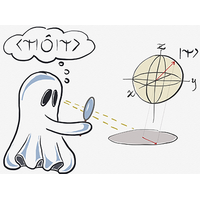Abstract
We provide a new perspective on shadow tomography by demonstrating its deep connections with the general theory of measurement frames. By showing that the formalism of measurement frames offers a natural framework for shadow tomography—in which “classical shadows” correspond to unbiased estimators derived from a suitable dual frame associated with the given measurement—we highlight the intrinsic connection between standard state tomography and shadow tomography. Such a perspective allows us to examine the interplay between measurements, reconstructed observables, and the estimators used to process measurement outcomes, while paving the way to assessing the influence of the input state and the dimension of the underlying space on estimation errors. Our approach generalizes the method described by Huang et al. [H.-Y. Huang et al., Nat. Phys. 16, 1050 (2020)], whose results are recovered in the special case of covariant measurement frames. As an application, we demonstrate that a sought-after target of shadow tomography can be achieved for the entire class of tight rank-1 measurement frames—namely, that it is possible to accurately estimate a finite set of generic rank-1 bounded observables while avoiding the growth of the number of the required samples with the state dimension.
- Received 13 February 2023
- Revised 24 July 2023
- Accepted 2 October 2023
DOI:https://doi.org/10.1103/PRXQuantum.4.040328
Published by the American Physical Society under the terms of the Creative Commons Attribution 4.0 International license. Further distribution of this work must maintain attribution to the author(s) and the published article's title, journal citation, and DOI.
Published by the American Physical Society
Physics Subject Headings (PhySH)
Popular Summary
A new perspective on shadow tomography, a technique to efficiently estimate properties of unknown quantum states, is proposed. Specifically, we unveil a tight link between shadow tomography and the broader theory of measurement frames, which allows the exploitation of the advantages held by shadow tomography in a previously unforeseen large class of experimental settings.
Such a link unravels the complex interaction between measurements, reconstructed observables, and estimators and provides a new tool to scrutinize how input states and space dimensions affect estimation errors. The proposed approach also demonstrates that the conceptual foundation of shadow tomography naturally emerges from broader metrological considerations and provides accurate estimations with a lower sample requirement as the state dimension grows.
Our work holds the promise of providing useful experimental routes for the inference of the properties of quantum states, a key task for the validation of quantum systems and processes that will increase in relevance as the size of noisy intermediate-scale quantum computing systems grow.



